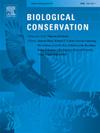保护干预措施试验的空间分布与全球保护需求不一致
IF 4.4
1区 环境科学与生态学
Q1 BIODIVERSITY CONSERVATION
引用次数: 0
摘要
调整研究工作以解决对生物多样性的主要威胁是在有限资源下扭转生物多样性丧失曲线的关键。最近,陆生两栖动物、鸟类和哺乳动物的全球威胁地图使我们能够评估主要威胁(伐木、狩猎、农业、污染、外来入侵物种和气候变化)的空间分布是否一致,并发表了针对这些威胁的保护干预措施的测试(保护证据数据库中整理的15种语言的1025项英语和147项非英语研究)。我们运行广义线性模型(GLMs)来确定每个国家测试两栖动物、鸟类和哺乳动物干预措施的研究数量的关键预测因子(包括社会经济因素)。我们发现研究和每个分类单元的威胁影响概率之间的空间一致性很差。研究分布在92个国家,64%的研究在美国、英国、加拿大和德国进行。大多数研究关注的是针对农业威胁的干预措施(分别占两栖动物、鸟类和哺乳动物的60%、79%和58%),其次是应对气候变化的干预措施(占鸟类研究的18%)、狩猎/诱捕(占哺乳动物研究的29%)和伐木(占两栖动物研究的20%)。威胁程度最高的国家通常很少或根本没有研究,尽管有几个国家的威胁程度和研究数量都很高,包括:德国对两栖动物对农业的干预,新西兰对鸟类对入侵物种的干预,以及巴西对哺乳动物对狩猎的干预。然而,我们的模型表明,某些社会经济因素,而不是威胁造成的保护风险水平,与更多的研究有关。这些因素包括国内生产总值(GDP)水平较高的国家(两栖动物和鸟类)和政府效率较高的国家(哺乳动物)。我们呼吁迅速采取行动,消除(和激励)干预措施报告测试的障碍,例如通过专门的资金来测试保护行动,并建立一个英语和非英语语言的全球报告数据库,以填补代表性不足地区的证据空白。建立“测试伙伴关系”,通过资助者、当地社区、政府、非政府组织和研究组织的网络将全球北方和全球南方的机构联系起来,也将有助于更好地协调干预措施的测试,以解决保护需求。这将需要国际协调来建立测试干预措施和报告其效果的能力,同时避免空降科学。本文章由计算机程序翻译,如有差异,请以英文原文为准。
The spatial distribution of tests of conservation interventions does not align with global conservation needs
Aligning research effort to address major threats to biodiversity is key to bending the curve of biodiversity loss with limited resources. Recent global threat mapping for terrestrial amphibians, birds, and mammals enabled us to assess whether there was alignment between the spatial distributions of key threats (logging, hunting, agriculture, pollution, Invasive Non-Native Species, and climate change) and published tests of conservation interventions addressing these threats (1025 English and 147 non-English language studies from 15 languages collated in the Conservation Evidence database). We ran Generalised Linear Models (GLMs) to determine the key predictors (including socio-economic factors) of the number of studies that test interventions on amphibians, birds, and mammals per country. We found poor spatial alignment between studies and the impact probabilities of threats for each taxon. Studies were distributed across 92 countries with 64 % of all studies conducted in the United States, United Kingdom, Canada, and Germany. Most studies focused on interventions against agricultural threats (60 %, 79 %, and 58 % for amphibians, birds, and mammals, respectively) – next most common were interventions tackling climate change (18 % of bird studies), hunting/trapping (29 % of mammal studies), and logging (20 % of amphibian studies). Countries with the highest threat levels typically had few or no studies, although several countries had both high threat levels and numbers of studies, including: Germany for amphibian interventions against agriculture, New Zealand for bird interventions against invasive species, and Brazil for mammal interventions against hunting. However, our modelling suggested that certain socio-economic factors, not levels of conservation risk posed by threats, were associated with more studies testing interventions. These factors included countries with higher levels of Gross Domestic Product (GDP) (amphibians and birds) and greater levels of government effectiveness (mammals). We call for rapid action to remove barriers to (and incentivise) reporting tests of interventions, such as through specific funding to test conservation actions and a global reporting database in both English and non-English languages to fill evidence gaps in underrepresented regions. Building ‘testing partnerships’ to link Global North and Global South institutions through networks of funders, local community, governmental, non-governmental and research organisations would also help to better coordinate testing of interventions to address conservation needs. This will require international coordination to build capacity for testing interventions and reporting their effects, whilst avoiding parachute science.
求助全文
通过发布文献求助,成功后即可免费获取论文全文。
去求助
来源期刊

Biological Conservation
环境科学-环境科学
CiteScore
10.20
自引率
3.40%
发文量
295
审稿时长
61 days
期刊介绍:
Biological Conservation is an international leading journal in the discipline of conservation biology. The journal publishes articles spanning a diverse range of fields that contribute to the biological, sociological, and economic dimensions of conservation and natural resource management. The primary aim of Biological Conservation is the publication of high-quality papers that advance the science and practice of conservation, or which demonstrate the application of conservation principles for natural resource management and policy. Therefore it will be of interest to a broad international readership.
 求助内容:
求助内容: 应助结果提醒方式:
应助结果提醒方式:


